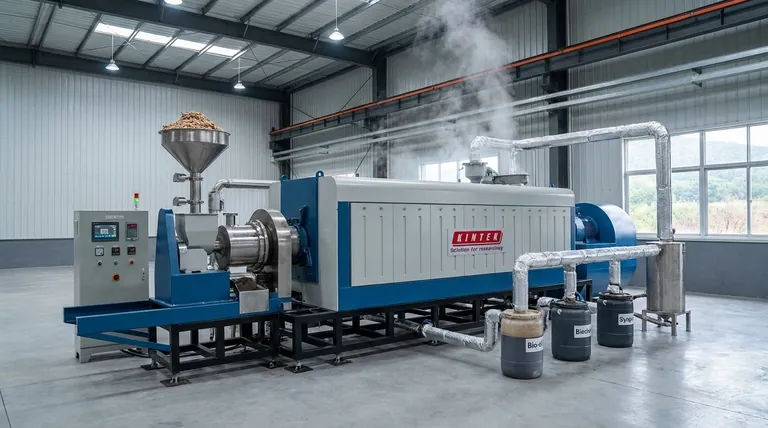To be clear, the environmental friendliness of pyrolysis is not inherent to the process itself; it is entirely dependent on the system's design, the specific material being processed (feedstock), and how the resulting products are used or managed. When optimized, pyrolysis can be a powerful tool for waste reduction and resource recovery, but a poorly controlled process can create its own set of environmental problems.
The central question is not whether pyrolysis is eco-friendly, but under what conditions it becomes an environmentally beneficial process. Its true value lies in transforming low-value waste into higher-value products like energy and stable carbon, but this outcome is never guaranteed.

How Pyrolysis Works: A Primer
The Core Process: Thermal Decomposition
Pyrolysis is a process of heating organic materials, such as biomass, plastics, or tires, to high temperatures in an oxygen-free or low-oxygen environment.
Instead of combusting (burning), the material breaks down chemically into smaller, different molecules. This fundamental difference is what gives pyrolysis its unique potential.
The Three Key Outputs
The process typically yields three main products:
- Bio-oil (or Pyrolysis Oil): A liquid fuel that can be a potential substitute for petroleum-based oils, though it often requires upgrading.
- Biochar: A stable, carbon-rich solid that resembles charcoal.
- Syngas (Synthesis Gas): A mixture of combustible gases (like hydrogen and carbon monoxide) that can be used to generate heat or electricity.
The Case for Pyrolysis as an Eco-Friendly Solution
Diverting Waste from Landfills
The most significant environmental benefit of pyrolysis is its ability to process waste that would otherwise end up in a landfill.
This reduces landfill volume, which in turn decreases the generation of methane, a potent greenhouse gas produced by decomposing organic matter.
Creating Renewable Energy
The syngas produced during pyrolysis can be used to power the process itself, making the system more energy-efficient. Any excess gas or the produced bio-oil can be used to generate electricity or heat, displacing the need for fossil fuels.
Carbon Sequestration with Biochar
Biochar is a highly stable form of carbon. When it is added to soil, the carbon is effectively locked away for hundreds or even thousands of years.
This process, known as carbon sequestration, removes carbon dioxide from the atmospheric cycle. Furthermore, biochar can improve soil health, water retention, and agricultural productivity.
Understanding the Risks and Trade-offs
Feedstock Contamination is Critical
The environmental safety of pyrolysis hinges on the purity of the input material.
If the feedstock (e.g., municipal solid waste, plastics) is contaminated with hazardous materials like heavy metals, chlorine, or sulfur, these elements can become concentrated in the bio-oil or biochar, or released as harmful air emissions.
The Importance of Process Control
As noted, variables like residence time (how long the material stays in the reactor) and temperature directly influence the final products.
An improperly managed system can produce lower-quality outputs or even create toxic byproducts. For example, incomplete conversion can result in tars and other complex hydrocarbons that are difficult and costly to manage.
Energy Balance and Efficiency
While pyrolysis can be a net energy producer, starting and maintaining the high-temperature, oxygen-free environment requires a significant energy input.
The overall "green" credentials of a facility depend on its net energy balance. If it consumes more energy from the grid than it produces, its environmental benefit is significantly diminished.
Making the Right Choice for Your Goal
When evaluating a pyrolysis system, its environmental impact is defined by your primary objective.
- If your primary focus is waste volume reduction: Prioritize systems that can handle your specific waste stream safely and achieve a high rate of material conversion.
- If your primary focus is energy production: Focus on the efficiency of syngas and bio-oil production and the system's overall net energy balance.
- If your primary focus is carbon sequestration: Optimize the process for high-quality, stable biochar production and ensure you have a viable plan for its use in soil.
Ultimately, a well-designed and properly managed pyrolysis system is a valuable environmental technology, but its benefits are conditional, not absolute.
Summary Table:
| Aspect | Eco-Friendly Potential | Key Considerations |
|---|---|---|
| Waste Management | Diverts waste from landfills, reduces methane emissions | Feedstock purity is critical to avoid contamination |
| Energy Recovery | Produces renewable energy (syngas, bio-oil) | Net energy balance must be positive for true sustainability |
| Carbon Sequestration | Biochar locks away carbon for centuries | Process must be optimized for high-quality, stable biochar |
| Process Control | Minimizes toxic byproducts and emissions | Requires precise temperature and residence time management |
Ready to implement a sustainable pyrolysis solution for your lab or facility? KINTEK specializes in advanced lab equipment and consumables, including pyrolysis systems designed for efficiency and environmental safety. Whether your goal is waste reduction, energy recovery, or carbon sequestration, our experts can help you optimize the process for maximum eco-friendly benefits. Contact us today to discuss your needs and discover how KINTEK’s solutions can transform your waste into valuable resources!
Visual Guide

Related Products
- Electric Rotary Kiln Small Rotary Furnace Biomass Pyrolysis Plant
- Customizable High Pressure Reactors for Advanced Scientific and Industrial Applications
- High Temperature Muffle Oven Furnace for Laboratory Debinding and Pre Sintering
- Graphite Vacuum Continuous Graphitization Furnace
- High Pressure Laboratory Autoclave Reactor for Hydrothermal Synthesis
People Also Ask
- What are the conditions for biomass pyrolysis? Optimize Temperature, Heating Rate & Time
- What is a disadvantage of biomass energy? The Hidden Environmental and Economic Costs
- What are the advantages of pyrolysis technology? Turn Waste into Profit and Reduce Emissions
- What are the components of biomass pyrolysis? A Complete Guide to the System, Products, and Process
- What are the different types of pyrolysis machines? Choose the Right System for Your Output



















